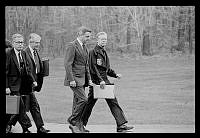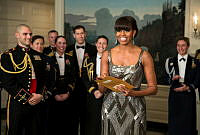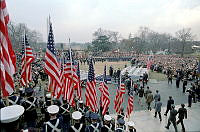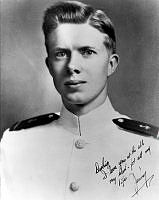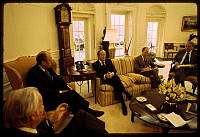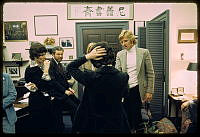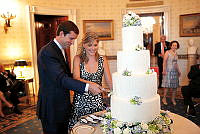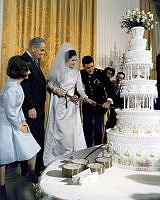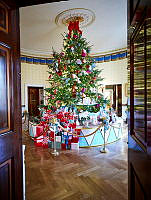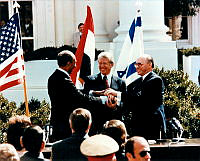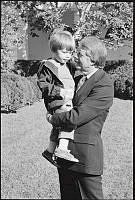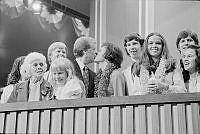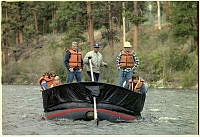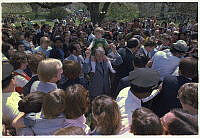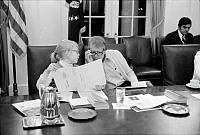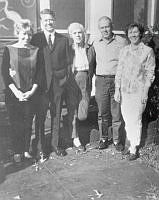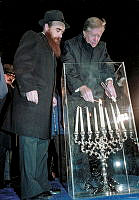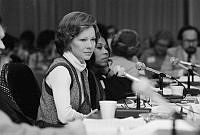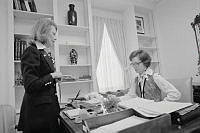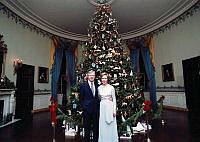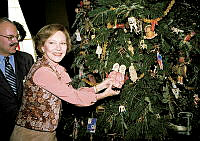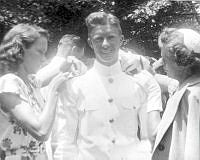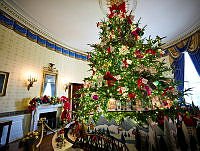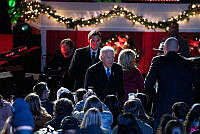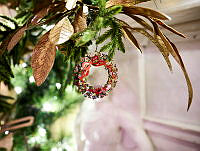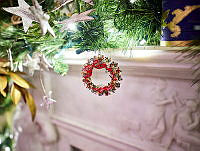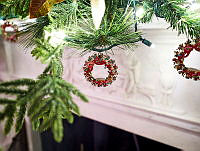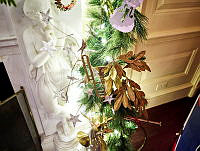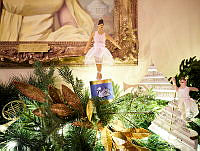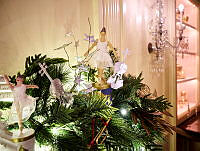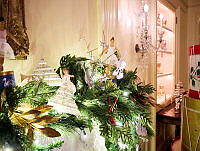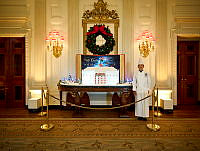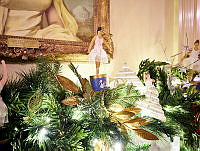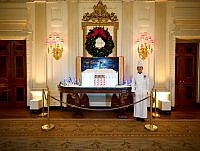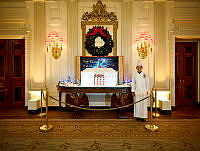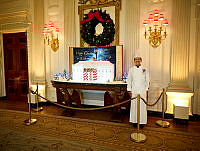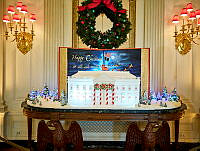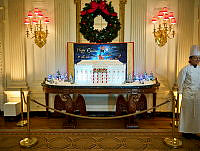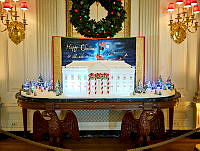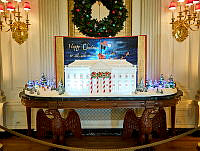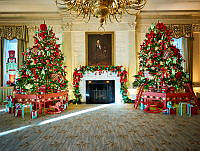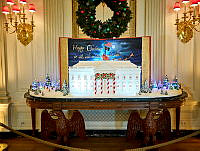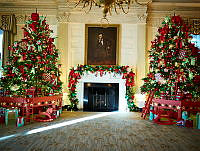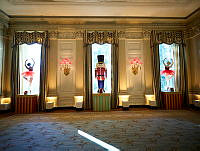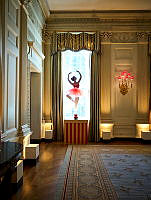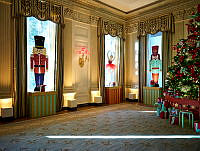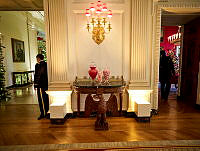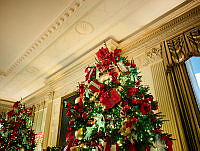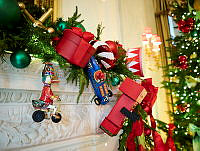History in the Camera's Eye
Copyright © 1983 White House Historical Association. All rights reserved under international copyright conventions. No part of this article may be reproduced or utilized in any form or by any means, electronic or mechanical, including photocopying, recording, or by any information storage and retrieval system, without permission in writing from the publisher. Requests for reprint permissions should be addressed to books@whha.org
Versailles, Potsdam, and other grand relics of power are all imposing architecture and vistas, one always leading to another— Ossa piled upon Pelion and Olympus over all. It is a difficult feat to summon up in these surroundings the ghosts of vanished absolutism or to imagine real people actually living and working in them.
The President's House, in Washington, by contrast, is a rather republican, almost bourgeois, affair. It has a street number (1600 Pennsylvania Avenue) like other dwellings, lawns in front and in back, and a modest rose garden. While not as pretentious as many other places in our democracy, it will stand up for classical design to a good 18th-century spread erected by, say, a British nobleman of the second rank—except, of course, that there is no forest, no lake, no avenue of trees; the grounds are very limited.
Business has closed in; its borders are busy main streets. Like a candy-store proprietor, the President lives over his work place. Offices have proliferated in the house and into its wings. There are news rooms, a Mess, and other impedimenta. It is the most powerful place in America, and, after its fashion, in the world.
If power is one thing the President shared with so many vanished Bourbons and Hohenzollerns and Stuarts, another is life in a fishbowl. The White House swarms with courtiers, and to this crowded scene has been added the modern press and, particularly, the camera's eye. Once past the stiff day of the daguerreotype and able to move with ever greater convenience, this device has been following our chief magistrates and their families with relentless enthusiasm, in the mansion and everywhere else they have gone for over a century.

The East Room draws tourists in the 1890s, during the second Cleveland administration, to admire the "New Grecian" decorations that had been added by President Grant in 1873. In the 19th century, the East Room became one of the most famous rooms in the United States and was a mecca for visitors to the capital.
White House Historical Association (White House Collection)Sometimes this has pleased the subjects. Abraham Lincoln went so far as to say that Mathew Brady's portrait of him (and the famous Cooper Union speech) won him the election of 1860. He gladly posed for Brady's photographers thereafter, and nothing much has changed since—except the number of photographers and their skill with ever more miraculous devices. There are now motion pictures, color film, and television.
As visitors come and go, "photo opportunities" proliferate; the clicking, the flashbulbs, the antics of the photographers jumping about to find a "shot" uncluttered with their rivals; the cries for "just one more picture, sir" would seem to be distracting and tiresome.

First Lady Jacqueline Kennedy was photographed informally upstairs in the oval sitting room of the family quarters.
Library of CongressBut not at all. The National Archives and the Library of Congress swell with thousands of photographs of a hearty Harding, a patient but frozen-faced Coolidge, a normally retiring Hoover—all obediently doing the camera's bidding. Franklin Roosevelt, like his cousin Theodore before him, never seemed to take a bad picture.
By Eisenhower’s time, in fact, a Navy photographer was stationed full time at the White House, lest history miss something; and there have been official operatives at it ever since. One of them, Yoichi Okamoto, scarcely left Lyndon Johnson's side, that is, the "good side," since Johnson fancied one profile more than the other.

Quentin Roosevelt, son of TR, and Roswell Flower Pinckney, son of White House steward Henry Pinckney, play near the South Portico in 1901, the year Theodore Roosevelt became the nation's 26th President.
Library of CongressToday the White House photo office has swollen to a staff of five photographers. You may smile at this bit of modern inflation, but the thoughtful historian will, upon reflection, not be displeased. Now he can see in the carefully edited White House version how each modern administration wanted to look, as in the work of court painters of old, which is sometimes rather different from candid press photographs with their distressing tendency to catch one frowning or scratching an ear, or, in the case of Coolidge, pitching hay in a business suit because the photographers asked him to.
Whether an Official photographer could have done anything to mask the massive bulk of William Howard Taft or the short stature of Benjamin Harrison (seat him on phone books, if there had been any, like Tom Dewey?) or to straighten out the necktie and rumpled garments of Abraham Lincoln must remain moot questions. It is good to have whatever we can get, plain or fancy.

The photograph of Madame Chiang Kai-shek meeting with Mrs. Roosevelt on the south lawn provides a study in contrasts and likeness of two great women. The encounter took place during World War II, when the wife of the Chinese generalissimo visited the White House with an entourage of forty servants and aides and remained for nine days.
Library of CongressThe camera, familiar as it is to us, is nevertheless a great miracle, superior in some ways to the pen. It is selective, but does not lie about what was before the lens. We are fortunate that, for so much of our tumultuous history, it has been opening steadily on this palace of democracy. It shows actuality, not myth—homely moments, with President Hoover and the winner of a preposterous "Typical Boy and Dog" contest; amiable ones, as in Frances Benjamin Johnston's photograph of little Quentin Roosevelt and the steward's son posed outside the mansion; and moments of such pomp and circumstance as could be mustered.
First families and First Ladies, some prim, some raffish, some homebodies, some beauties, never fail to fascinate the people who placed them in the fishbowl, even after they leave the White House. We follow them as avidly as the British do the triumphs and embarrassments of the House of Windsor, not to mention that we keep a collective eye on changes in the furniture and decor and argue about whether there should be a balcony on the South Front.
These pictures are part of a family photograph album of the American people. Old Dr. Oliver Wendell Holmes, poet and physician, father of the jurist, was enchanted by the camera. "The mirror with a memory," he called it. What memories it brings us from 1600 Pennsylvania Avenue, national palace, national homestead, for rent every four years!
If the vistas are as short as the leases, the memories are long and as palpable as if each were but a second ago. In a moment, the beautiful young Mrs. Cleveland will get up to stretch, guests will pour into the State Dining Room under TR's stuffed animal heads, young Quentin and his friend will wander off to some new devilment, and Mr. Lincoln will cross the lawn to the telegraph office for the latest bulletins from the Army of the Potomac.

Mourners kneel in prayer on the north driveway outside the windows of the East Room where President Harding's remains lie in state. Possibly a staged photograph - because of its studied poses and framing and because the Secret Service limited public access to the driveway - this image, nevertheless, captures the profound grief that followed Harding's sudden death in San Fransisco in 1923, when he was on a western tour.
Library of Congress












